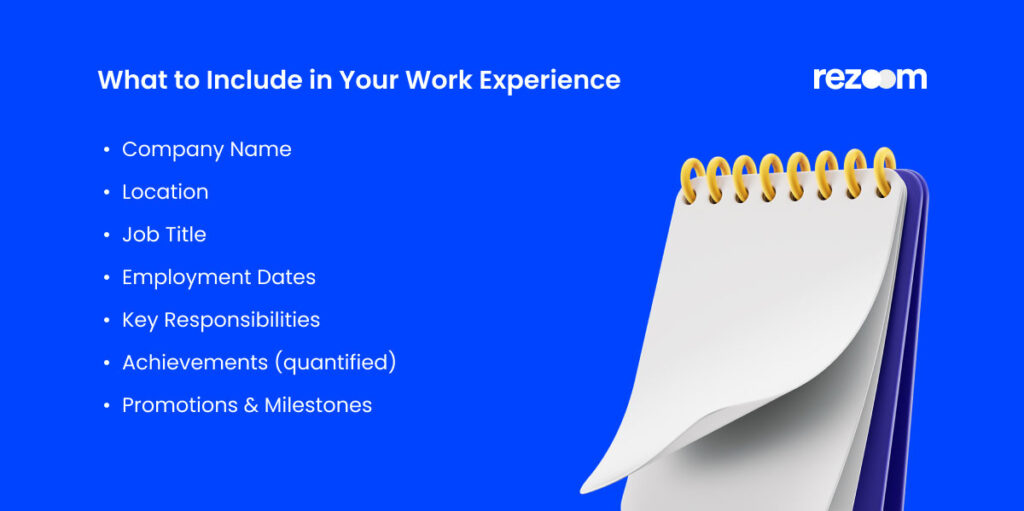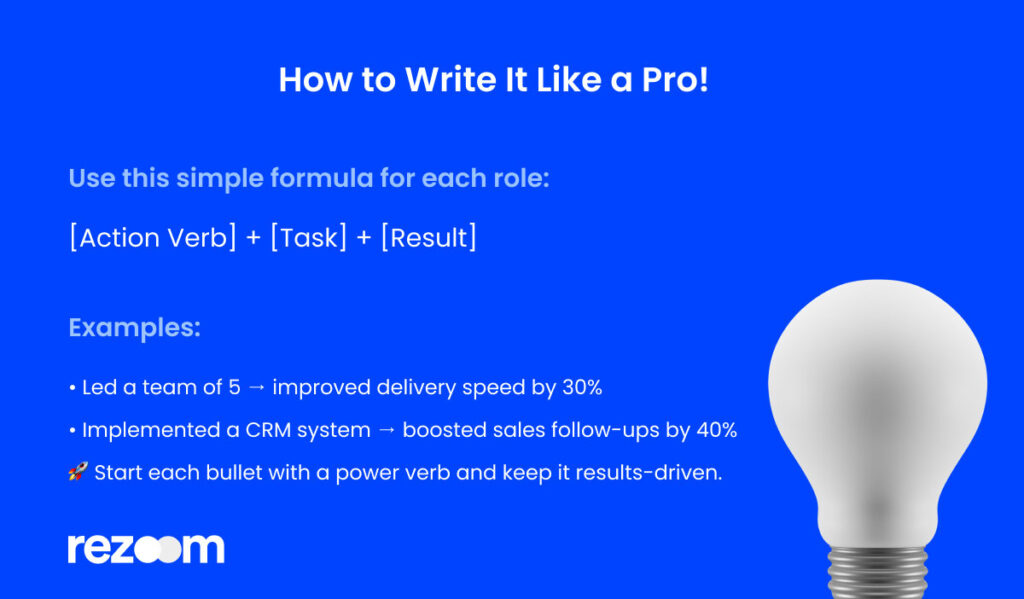How to Write Work Experience on a Resume

Your resume is more than a document listing your past jobs it’s the narrative of your professional journey. One of the most critical sections is writing work experience on a resume. In this guide, we outline step-by-step advice to help you craft a detailed, professional work history that engages employers and highlights your accomplishments.
Recommended Podcast:
Throughout this article, you will learn how to effectively approach writing work experience on a resume, including:
- Why writing work experience on a resume is vital for your career
- Essential details to include
- Recommended formats to showcase your job history
- Step-by-step methods for writing work experience on a resume with clear examples
- Common pitfalls to avoid
- Strategies for candidates with limited experience
- Answers to frequently asked questions
- Key takeaways that round out your professional narrative
Let’s get started.
1. Why Writing Work Experience on a Resume Matters
Writing work experience on a resume is crucial because this section provides a snapshot of your professional journey. Employers use this part of your resume to gauge your skills and career progression. When you write work experience on a resume effectively, you are not merely listing your job duties you are telling a story of growth, expertise, and success.
- First Impressions:
Your work history is often the first area that potential employers focus on. Clear and impactful entries show that you take your career seriously. - Proving Your Value:
When you write work experience on a resume with detailed achievements, you provide measurable evidence of your contributions. - Career Narrative:
A well written work experience section helps employers understand the evolution of their careers, highlighting key milestones and skills acquired.
For more insights on why highlighting your professional journey matters, check out Indeed’s Career Guide.
2. Essential Information to Include

When writing work experience on a resume, each entry should contain the following essential details:
- Job Title:
Use the industry-standard title so that your role is clearly understood. If your official title is unique, consider adding a conventional equivalent in parentheses. - Company Name and Location:
Include the full company name and its location. This contextualizes your experience and indicates the scale of your work environment. - Dates of Employment:
List the start and end dates (month and year) for each position. This information lays out your career timeline. - Responsibilities and Achievements:
Use bullet points to articulate your core responsibilities and the achievements in that role. Quantify your accomplishments where possible (e.g., “boosted sales by 20%”). - Skills and Tools:
Mention the skills, software, and technologies you used. This additional layer illustrates your technical proficiency.
Ensuring all these elements are included makes your resume a compelling document that supports your job candidacy.
3. Best Formats for Writing Work Experience on a Resume
When it comes to writing work experience on a resume, the format you choose can significantly impact how your information is received. Consider these three primary resume formats:
Chronological Resume (Reverse-Chronological Format)
- Description:
List your work experience starting with your most recent role and working backward. - Ideal For:
Candidates with a consistent work history and a clear upward trajectory. - Advantage:
It naturally emphasizes your most recent and relevant experience.
Functional Resume
- Description:
Focuses on your skills and accomplishments rather than a chronological job history. - Ideal For:
Those with gaps in employment or who are shifting careers. - Advantage:
It highlights transferable skills and core competencies.
Combination Resume (Hybrid Format)
- Description:
Merges the chronological listing with a functional overview, often starting with a skills summary. - Ideal For:
Candidates who have both a strong skill set and a solid work history. - Advantage:
It provides flexibility to tailor your resume to your audience’s needs.
Selecting the appropriate format ensures that you are writing work experience on a resume in a way that best reflects your unique professional journey.
4. Step-by-Step Guide for Writing Work Experience on a Resume
Here’s a detailed, step-by-step guide on writing work experience on a resume that showcases your achievements and helps you stand out.
Step 1: Choosing the Right Job Titles for Writing Work Experience
Your job title is the very first element of each entry. Here’s how to choose an effective title:
- Accuracy and Clarity:
Use a title that accurately reflects your role. If necessary, add the standard industry term in parentheses. - Reflect Responsibility:
Choose a title that conveys the scope of your work. For example, if you led a team, include “Manager” or “Supervisor” in your title. - Industry Keywords:
Align your title with common industry terms. This ensures clarity when hiring managers and automated systems are evaluating your resume.
Your job title sets the stage for the rest of the entry and is a critical aspect of writing work experience on a resume.
Step 2: Crafting Effective Job Descriptions
Once you’ve set the job title, focus on writing clear, effective descriptions for each role:
- Organize with Bullet Points:
Use bullet points to break down your responsibilities and achievements. - Action-Oriented Language:
Start each bullet with a strong action verb like “managed,” “developed,” or “implemented.” - Focus on Achievements:
Instead of merely listing duties, describe how your efforts benefited the organization. For example, “Increased customer engagement by 15%” is more powerful than “Handled customer interactions.” - Quantify When Possible:
Numbers and percentages give weight to your accomplishments. They make your achievements tangible for the reader.

Clear, concise descriptions elevate the quality of writing work experience on a resume, turning routine tasks into evidence of success.
Step 3: Highlighting Achievements and Measurable Results
To make your work experience stand out, highlight the results you achieved:
- Emphasize Outcomes:
Detail the impact you made in your role. Use phrases like “boosted performance” or “reduced costs” to showcase measurable improvements. - Include Specific Metrics:
Even if precise figures aren’t available, use comparative terms (e.g., “significantly increased” or “remarkably improved”) that communicate measurable outcomes. - Use Comparative Statements:
When possible, compare your performance to benchmarks or previous periods. This provides context and underscores your contributions.
By focusing on achievements, you ensure that your approach to writing work experience on a resume transforms mundane duties into a compelling narrative of professional impact.
Step 4: Tailoring Your Experience for Each Application
Every job opportunity is unique, and you should tailor your resume accordingly:
- Analyze the Job Requirements:
Read the job description carefully and identify the skills and achievements most relevant to the role. - Emphasize Relevant Experiences:
Rearrange bullet points so that the most pertinent achievements appear first. - Customize Your Language:
Adjust your descriptions to match the terminology and requirements of the prospective job. - Focus on Value:
Ensure every detail in your work experience entry reinforces why you are the right candidate for that particular role.
This tailored approach to writing work experience on a resume ensures that your document resonates with hiring managers for each specific opportunity.
5. Common Pitfalls When Writing Work Experience on a Resume
Even with the best guidance, there are pitfalls to avoid when writing work experience on a resume:
- Vague Statements:
Avoid non-specific language like “performed various tasks.” Instead, detail your responsibilities and successes explicitly. - Overloading with Irrelevant Information:
Focus on the positions and details most relevant to your target job. Summarize or omit unrelated roles. - Inconsistent Formatting:
Use a uniform structure for each entry. Consistent dates, bullet points, and headings reflect professionalism and attention to detail. - Excessive Jargon:
Use industry-specific terms judiciously. While precision is good, clarity should never be sacrificed. - Neglecting Achievements:
Do not merely list your responsibilities. Emphasize what you accomplished in measurable terms.
Keeping these pitfalls in mind helps ensure that your resume stays focused and persuasive when you’re writing work experience on a resume.
6. Real-world examples of Work Experience Entries
Below are examples from different industries that illustrate how to write work experience on a resume effectively.
Marketing Manager Example
Software Developer Example
Sales Representative Example
These examples serve as models for writing work experience on a resume that is both detailed and results-driven.
7. Deciding How Far Back to List Your Experience
When determining how far back to list your work experience on a resume, consider the following:
- Prioritize Relevance:
Highlight roles that are most applicable to the job you are seeking, typically covering the last 10–15 years. - Quality Over Quantity:
It is preferable to feature a few well-documented roles rather than an exhaustive list of every position you’ve held. - Showcase Career Progression:
Include earlier roles only if they demonstrate growth and the development of your skill set. - Addressing Gaps:
Briefly mention any significant breaks in your career within your cover letter or resume summary as needed.
Select and present the positions that best illustrate your competence and fit for your target role when writing work experience on a resume.
8. Grammar and Language Tips for Writing Work Experience on a Resume
The language you use in your resume is integral to its impact. Follow these language guidelines for effective writing work experience on a resume:
- Use Consistent Tense:
Write previous roles in the past tense and your current role in the present tense. - Keep It Clear and Concise:
Use bullet points and succinct sentences to ensure your points are easy to read and understand. - Adopt an Active Voice:
Active language, such as “implemented” and “managed,” creates a dynamic description of your skills and contributions. - Proofread:
Meticulously review your resume to eliminate any grammatical or spelling errors. - Avoid Redundancy:
Vary your word choices to keep the content engaging and ensure that each bullet point offers new information.
These tips help maintain a professional tone and clarity, making your resume stand out when writing work experience on a resume.
9. Writing Work Experience on a Resume When You Have Limited Experience
Not everyone has a long professional history. If you have limited experience, here are strategies to still create a powerful work experience section:
- Highlight Internships and Part-Time Roles:
Even if your roles were short-term or unpaid, treat them as professional experience. Emphasize the skills you gained. - Include Volunteer Work and Projects:
Volunteer activities and academic projects can illustrate your ability to work in a professional setting and deliver results. - Emphasize Transferable Skills:
Focus on the skills you have acquired through different experiences, such as teamwork, problem-solving, and leadership. - Present a Clear Narrative:
Even with limited experience, structure your resume to show growth and development. Make each bullet point count by emphasizing your contributions.
By creatively highlighting every relevant experience, you ensure that you are effectively writing work experience on a resume, regardless of the length of your professional background.
10. Frequently Asked Questions
No, focus on roles that are relevant to your current career path. Summarize older or less relevant roles.
Briefly explain any significant gaps through freelance work, volunteer projects, or continuing education in your cover letter.
Yes, if your official title is unusual, you may include a conventional equivalent in parentheses to improve clarity.
Emphasize internships, volunteer work, academic projects, and freelance jobs. Showcase transferable skills and measurable outcomes.
Use qualitative terms or comparative language to illustrate significant improvements or contributions.
11. Key Takeaways: Presenting Your Work Experience Like a Pro
- Be Precise:
Ensure every detail in your work experience is clear and supported by results. Using measurable data elevates your accomplishments. - Follow a Structured Format:
Choose the format that best showcases your career progression—whether chronological, functional, or hybrid. - Tailor Your Content:
Customize each entry to align closely with the job you’re targeting. Let your achievements speak to your potential contributions. - Maintain a Professional Tone:
Use active, clear language that is free of errors. Proofread carefully for maximum clarity. - Focus on the Impact:
Rather than simply listing duties, emphasize the difference you made in each role by providing measurable outcomes. - Regularly Update Your Resume:
Keep your resume current by adding new roles and refining existing entries as your career advances.
By following these guidelines, you can effectively write work experience on a resume that highlights your professional journey, making your resume a powerful tool in your job search.
Conclusion
Writing work experience on a resume is both an art and a strategic process. It’s about showcasing your professional journey, quantifying your achievements, and demonstrating your value to potential employers. Whether you have an extensive career history or are just starting out, the key is to present your experience in a clear, compelling, and tailored way that sets you apart.
Remember:
- Invest time in detailing your roles and accomplishments with measurable outcomes.
- Tailor your resume for each application by highlighting the most relevant experiences.
- Use a consistent, clear format that communicates your professionalism at first glance.
- Continually update your resume to reflect new achievements and evolving skills.
Follow this guide, apply these principles, and start writing work experience on a resume that truly represents who you are as a professional. Let your resume tell a compelling story of success and potential, positioning you for the career opportunities you deserve.
Happy writing, and here’s to your future success!
Rate this article
11 people rated this article



Comments